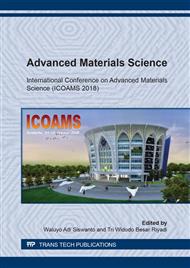p.3
p.10
p.16
p.23
p.30
p.39
p.45
p.51
Effect of NaOH Concentration Treatment on Tensile Strength, Flexure Strength and Elasticity Modulus of Banana Fiber Reinforced Polyester Resin
Abstract:
Banana fiber is agricultural waste that can be obtained after harvesting the fruit with no additional cost. Banana fiber has major drawbacks in composite product such as low interfacial bond strength between fiber and matrix as comparison with synthetic fiber. The aim of this research is to investigate the effect of alkaline concentration treatment conditions on tensile strength and flexural strength properties of banana fiber reinforced polyester resin composite. Banana fiber was treated using sodium hydroxide (NaOH) treatment. There are four variations of NaOH concentration treatment, 0%, 5%, 10% and 15% for 1 hour immersion time at room temperature. Hand lay-up technique was used in composite fabrication with 40% fiber volume fraction at random orientation of banana fiber. Based on this research result can be concluded that composite with NaOH treatment has a better tensile strength and flexural strength if compared with untreated fiber. Banana fiber composite treated with 5% NaOH concentration show the highest tensile and elasticity modulus, and also flexural strength and flexural modulus better compare the other treatment. Banana fiber composite specimens on macro picture observation show that the untreated fiber has a lot of fiber pull-out, it is occur the weak interfacial bond between matix and fiber. On the other hand, the treated banana fiber composite shows a slight fiber pull out, because composite has high interfacial bond between matrix and fiber.
Info:
Periodical:
Pages:
10-15
Citation:
Online since:
July 2019
Authors:
Price:
Сopyright:
© 2019 Trans Tech Publications Ltd. All Rights Reserved
Share:
Citation:


